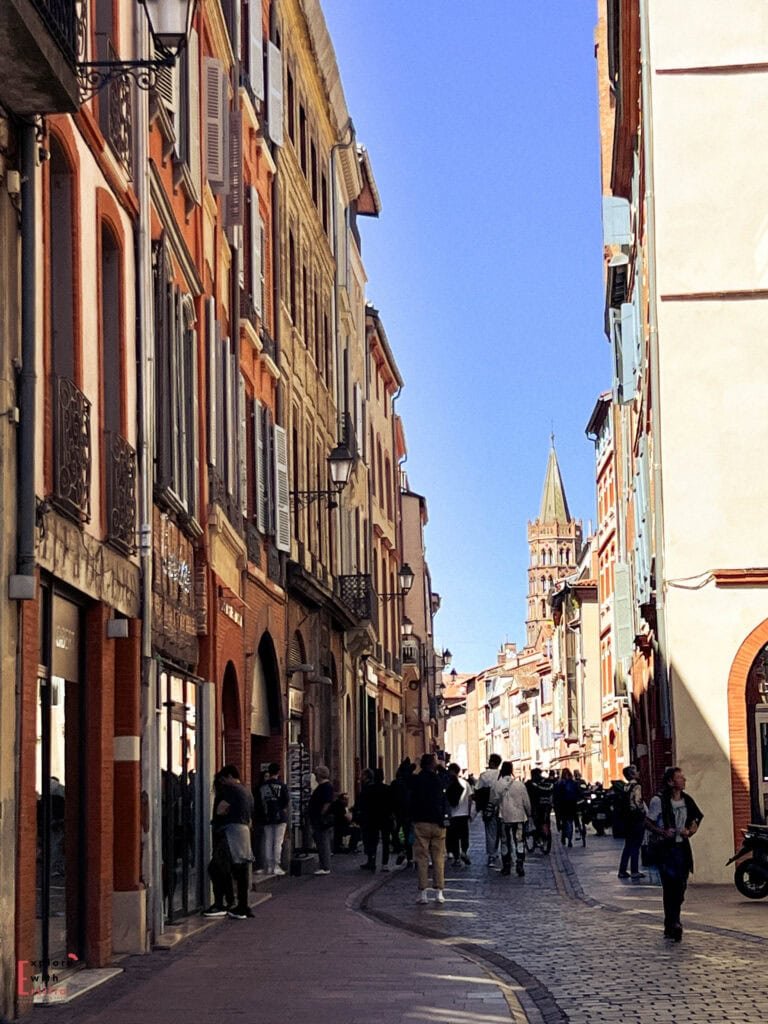Explore with Ersilia contains affiliate links and is a member of the Amazon Services LLC Associates Program. If you make a purchase using one of these links, I may receive compensation at no extra cost to you. affiliate links are how we keep this content free. A huge thanks if you use these as it helps a lot! See the Full Policy for more information.
Did you know there’s a medieval village in Provence where the streets are perfumed with violets year-round?
Most people go to the French Riviera and focus only on the well know Eze village.
Don’t get me wrong, Eze is magnificent and well deserving of it’s fame, but there are so many incredible places nearby that most people haven’t heard about.
Tourrettes-sur-Loup is one of them.
Perched dramatically on a rocky spur between Nice and Vence, Tourrettes-sur-Loup isn’t just another pretty French village – it’s the ‘Cité des Violettes,’ where artisans have been crafting everything from violet jam to candied flowers since the 1800s.
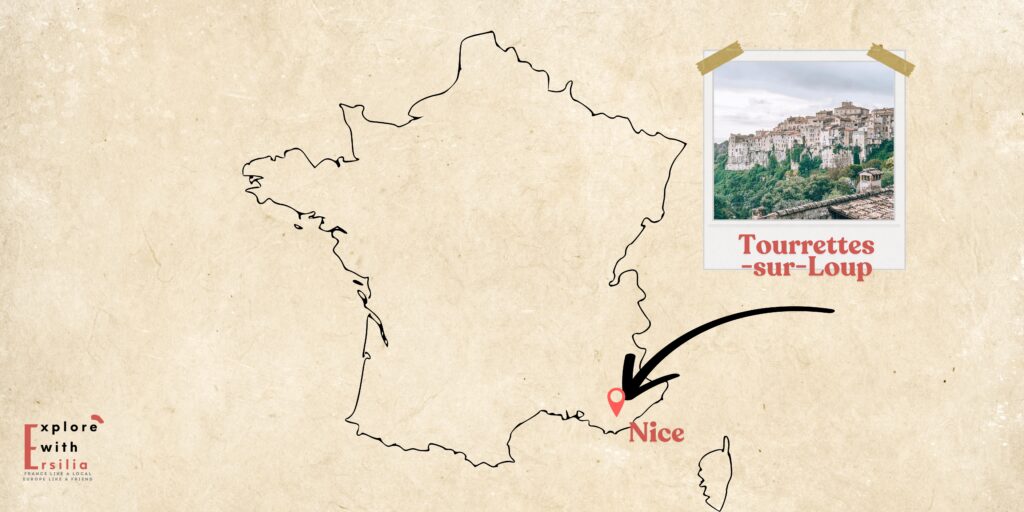
And trust me, it’s exactly the kind of place that will make you wonder why you ever stuck to the crowded streets of Nice or Saint-Paul-de-Vence!
Getting here is part of the adventure. From Nice, it’s a scenic 45-minute drive through the Provençal countryside.
Take bus #510 if you’re using public transport – the views of the Mediterranean as you wind up into the hills are worth every hairpin turn. I always recommend getting here early to watch the morning light illuminate the stone facades and catch the local bakers preparing the day’s fresh violet-flavored treats.
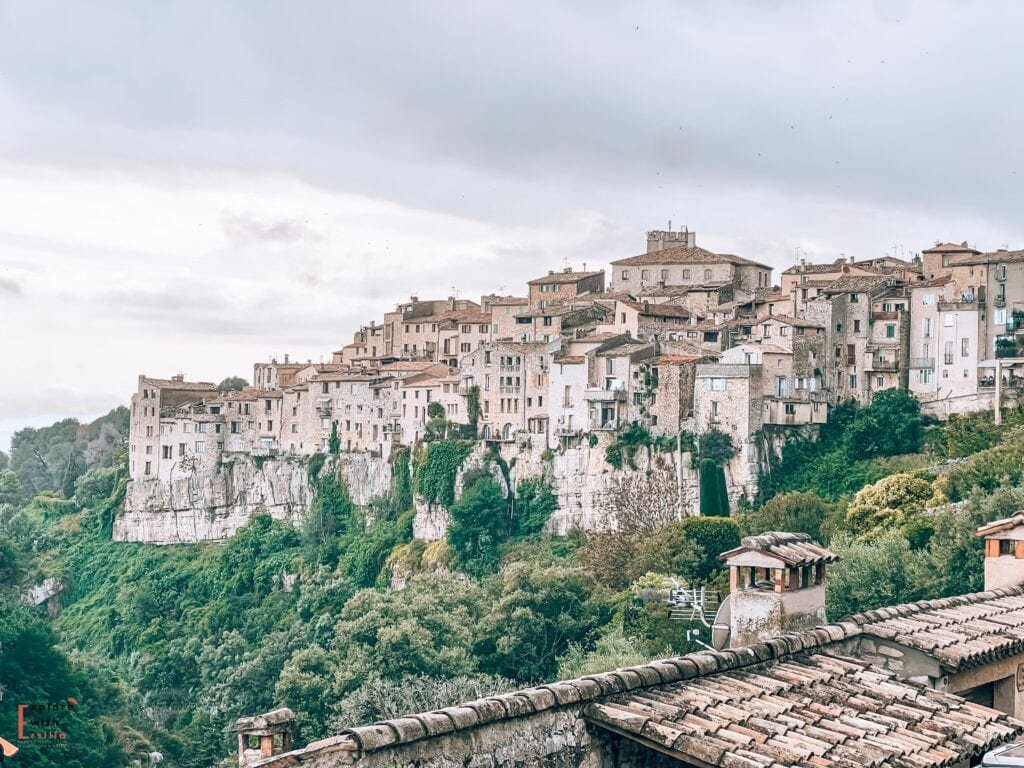
What Makes Tourrettes-sur-Loup Special
I’ll never forget my first visit to Tourrettes-sur-Loup. While searching where to base in the French Riviera, I stumbled upon this village almost by accident.
I was looking for a calm place to come back to every night and this looked just perfect.
The moment I stepped through the medieval gate, it felt like entering a world where time had gracefully paused. Unlike its famous neighbor Saint-Paul-de-Vence, packed with tourists year-round, Tourrettes-sur-Loup maintains an authentic charm that’s increasingly rare in the French Riviera.
The village’s identity is deeply intertwined with its violet cultivation tradition. Since the 1800s, these delicate flowers have been more than just a pretty sight – they’re the heart of local culture.
From January to March, the surrounding fields transform into a purple canvas, but the village celebrates its violet heritage year-round through its artisanal products, from soaps to syrups.
What truly sets Tourrettes-sur-Loup apart is its thriving artisan community. While many medieval villages have become mere tourist attractions, this one pulses with creative energy.
Dozens of artists and craftspeople have made their homes and workshops in the ancient stone buildings, creating everything from handwoven textiles to contemporary sculptures. It’s like walking through a living museum where every open door reveals another artist at work.
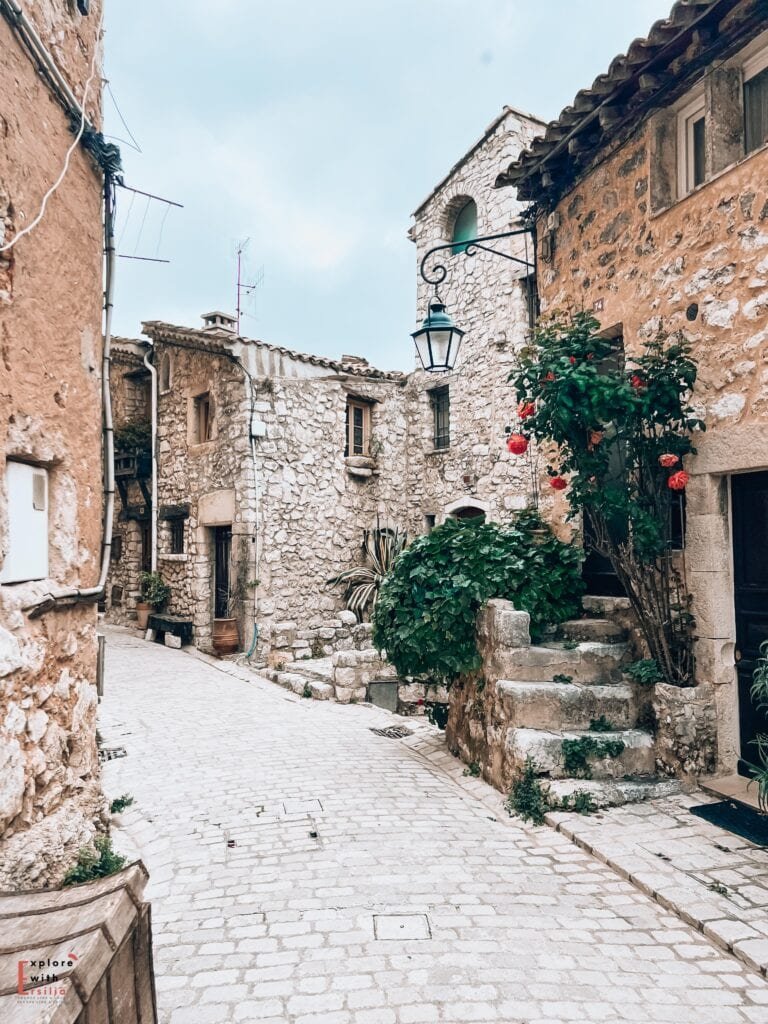
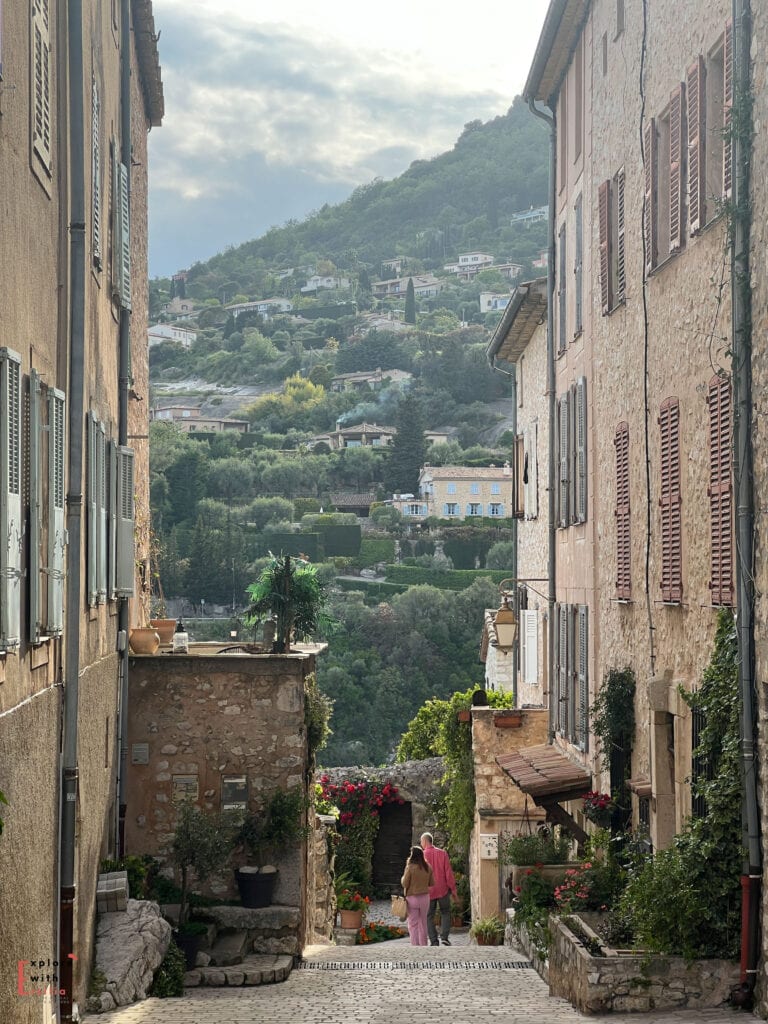
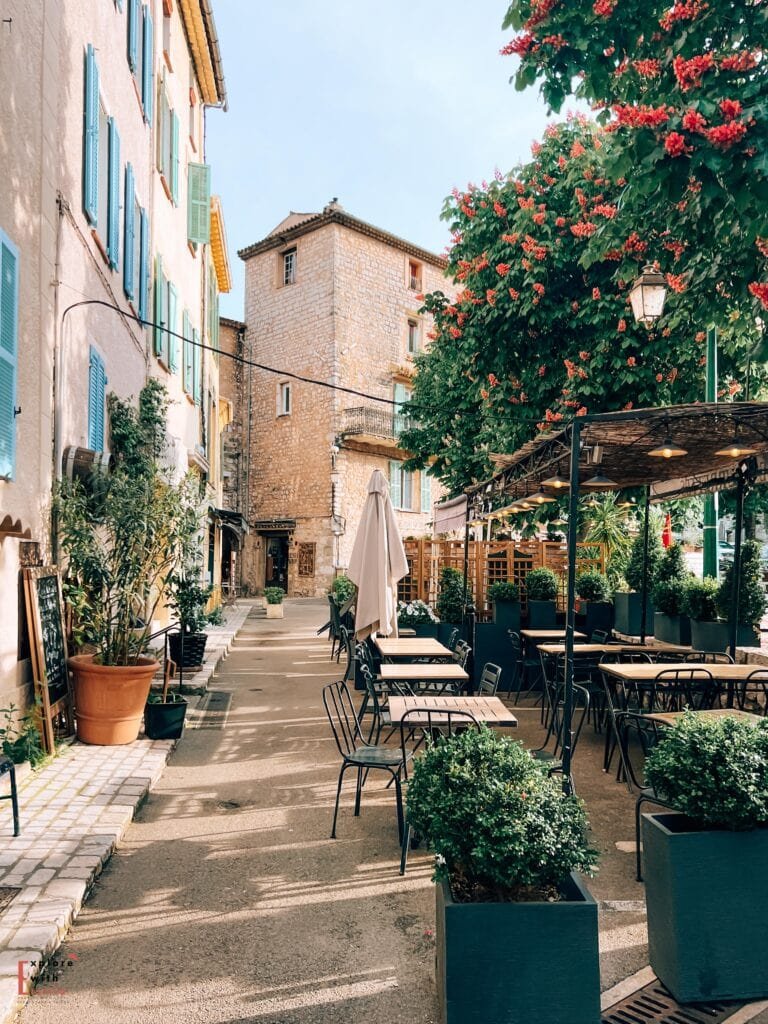
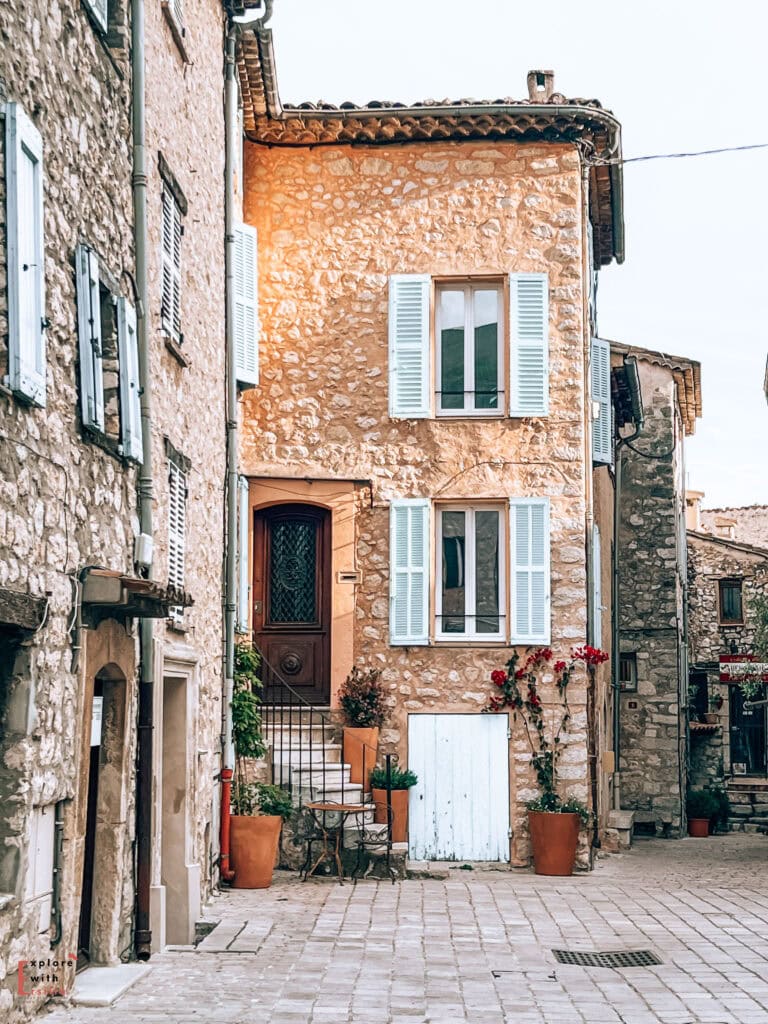
Local Experiences You Can’t Miss
The Grand Rue, the village’s main artery, isn’t just another pretty street – it’s a showcase of local artistry. Each workshop-gallery tells its own story, from glass-blowers creating delicate pieces to weavers working on traditional looms. Don’t rush through; take time to chat with the artisans. Many are happy to demonstrate their craft and share stories that span generations.
Want the best photo spot in town? Get to the public parking. There is a bridge from where you can get by foot to the village. This is the perfect spot to see the entire stone structure with the mountains behind.
Don’t overlook the medieval ramparts walk. This ancient defensive wall now serves as a circular pathway offering breathtaking views of the Loup valley. Time your walk for sunset, when the golden light transforms the limestone cliffs and the distant Mediterranean into a painter’s palette.
The real magic happens during the annual Fête des Violettes in March. The entire village transforms into a celebration of its beloved flower, with music, traditional dances, and violet-inspired cuisine. Even if you miss the festival, you can still experience this tradition at Victoria Violet, a family-run shop where four generations have been crafting violet confections.
Best Time to Visit & Practical Tips
For the most magical experience, visit between January and March when the violet fields are in full bloom. The sight (and scent!) of thousands of violets carpeting the terraced fields is unforgettable. However, don’t write off other seasons – spring brings wild flowers to the surrounding hills, and summer evenings are alive with outdoor concerts and art exhibitions.
Weather-wise, Tourrettes-sur-Loup enjoys the typical Provençal climate – mild winters and sun-drenched summers. July and August can be scorching, so plan your walks for early morning or late afternoon. The mistral wind can be fierce in spring and autumn, but it creates those famously clear, bright skies that painters have loved for centuries.
Here’s a money-saving tip: while the village is perfect for a day trip from Nice or Antibes, staying overnight lets you experience its true character after the day-trippers leave.
Several historic homes have been converted into charming B&Bs, often at prices lower than coastal hotels. Plus, many offer terraces with valley views – perfect for that evening glass of local rosé!
A practical note about getting around: the village is entirely pedestrian, with steep, narrow streets. Wear comfortable shoes with good grip – those medieval cobblestones can be slippery! Parking is available at the entrance to the village, and it’s best to arrive early as spaces fill quickly, especially during violet season.
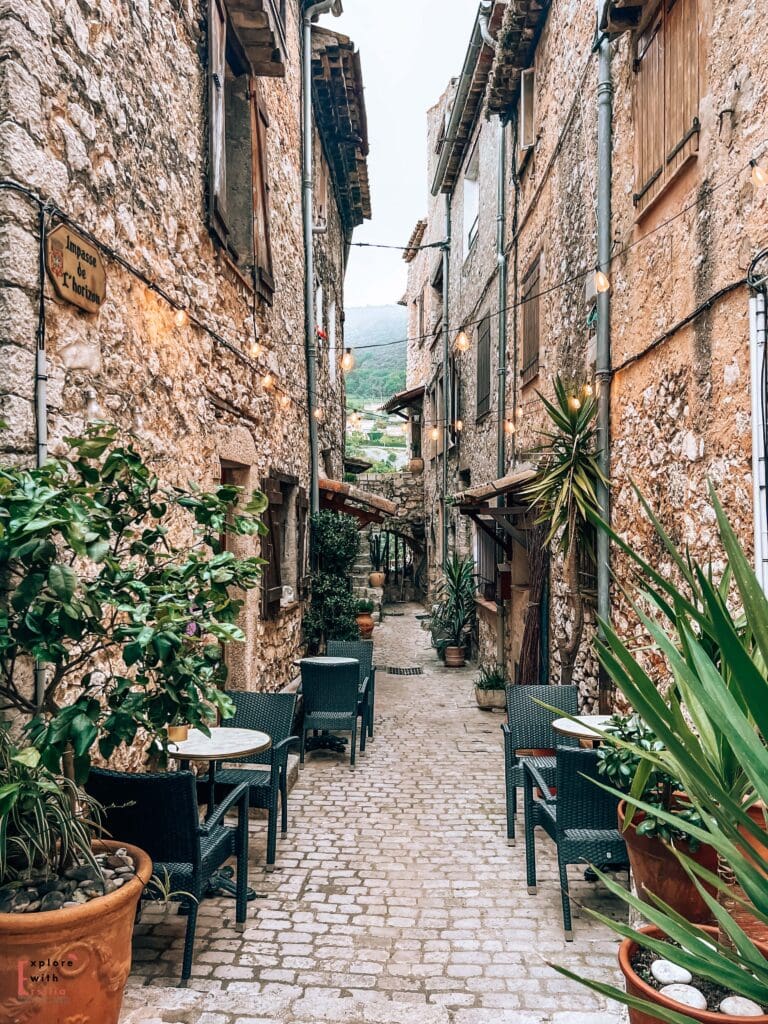
Where to Eat Like a Local
The village’s culinary scene is a delightful mix of traditional Provençal flavors and creative violet-inspired dishes. Le Sansot, housed in a 16th-century building, offers a terrace with sweeping views and a menu that changes with the seasons. Their violet crème brûlée is legendary!
For a casual lunch, join locals at Chez L’Ami Paul. Their daily specials often feature products from nearby farms, and the shaded terrace is perfect for people-watching. Don’t miss their violet-infused aperitif – it’s a local specialty that perfectly captures the village’s essence.
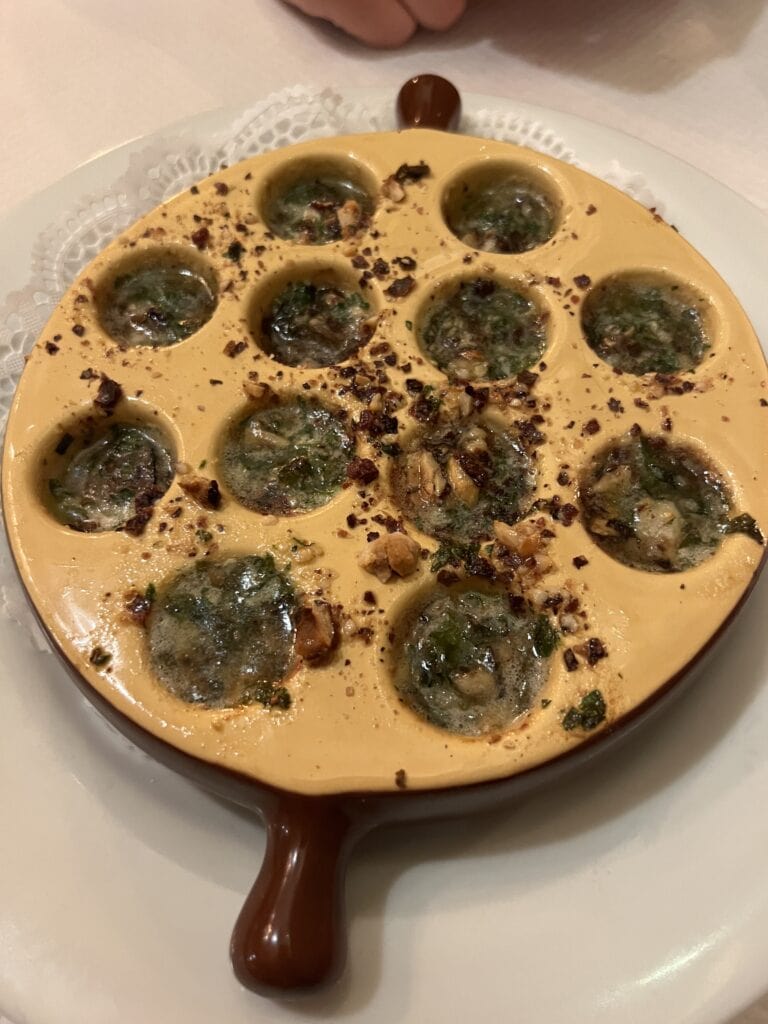
The Wednesday morning market transforms Place de la Liberation into a feast for the senses. Local producers bring their seasonal bounty – from fresh goat cheese to honey from nearby lavender fields. This is your chance to assemble a perfect picnic to enjoy on the ramparts.
Remember French dining hours are strict here: lunch is served 12-2PM, and dinner starts at 7:30PM. Many restaurants close completely in the off-season, so always call ahead to check opening hours.
I know you might not be looking for italian pasta when comming here, but I discovered the best italian restaurant, run by a very welcoming couple. Raviolette – Pastificio! We eneded eating there 3 times in a week, so I can definetly recommend it to you! They make a homemade limoncello from their neighbours fruits, and it’s amazing! I still have one bottle in my fridge!
Where to Stay: Hidden Gems & Local Favorites
We chose a charming “Chambre de hôtes” near the village and we absolutely loved it !
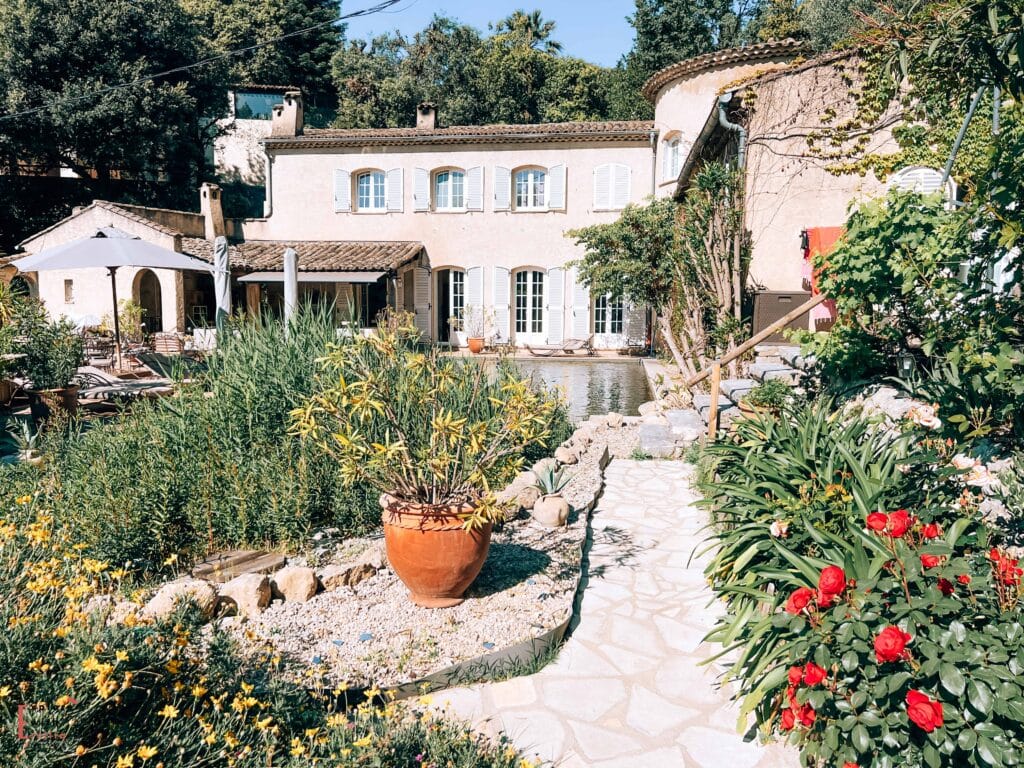
At Le Mazet des Tourrettes, all the rooms have seaview, the breakfast is home made and varies every morning (there is for every taste, salted or sweet). I loved getting up and enjoying my croissant and tea with a look over the sea from their terrace !
Twice a week the hosts (a lovely couple) organise what it is called ” la table d’hôte” – a meal where you can eat will the other guests, sharing a home cooked meal (very tasty!) and a glass of local wine. I can only recommend to do this !
Bonus : There is a natural pool where you can relax and enjoy this riviera vibe!
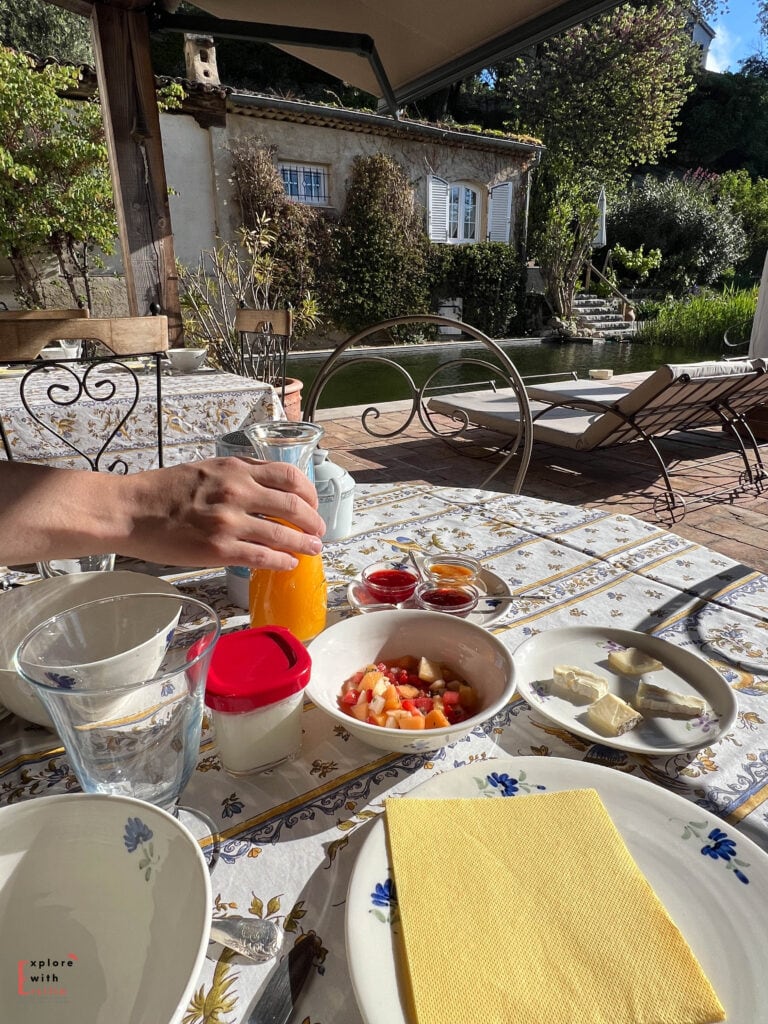
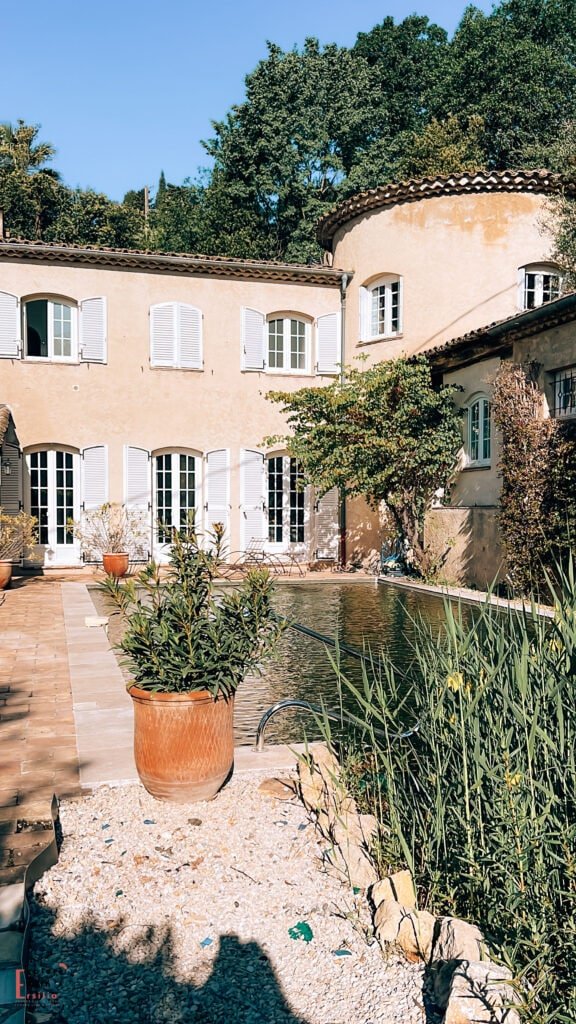
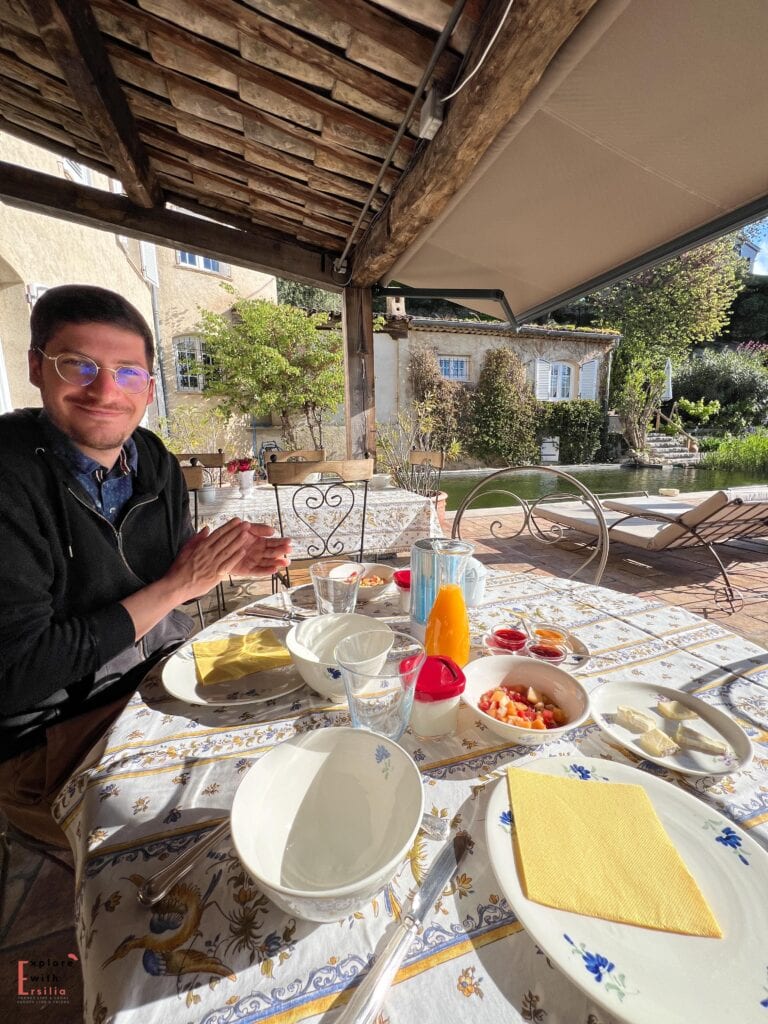
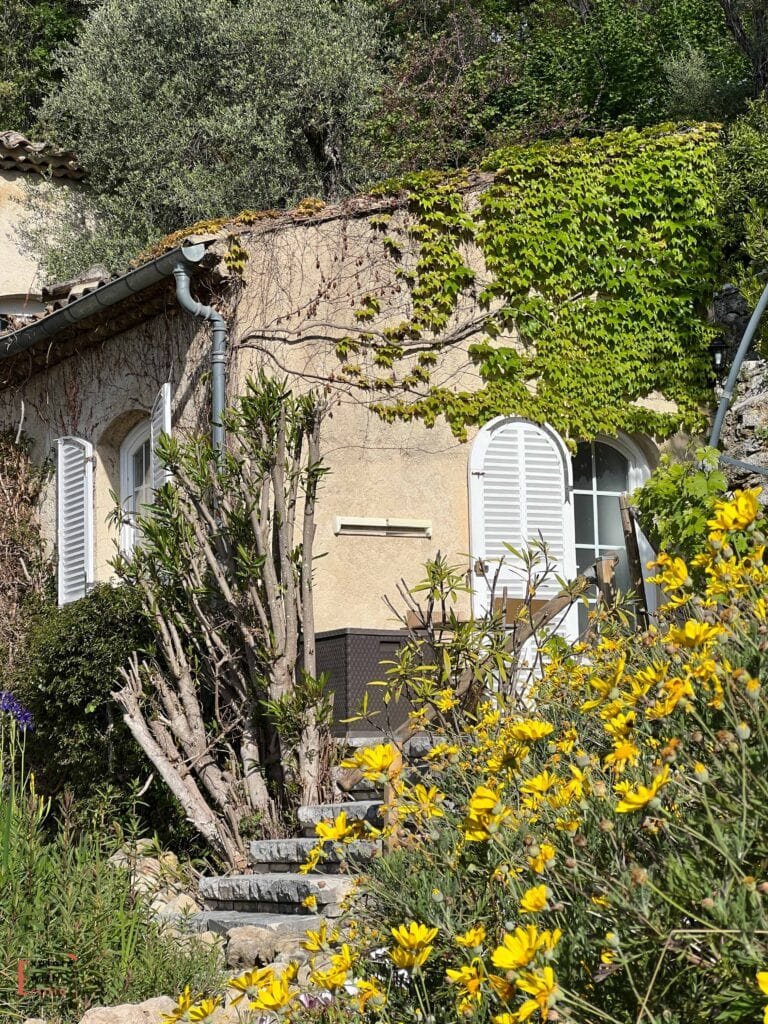
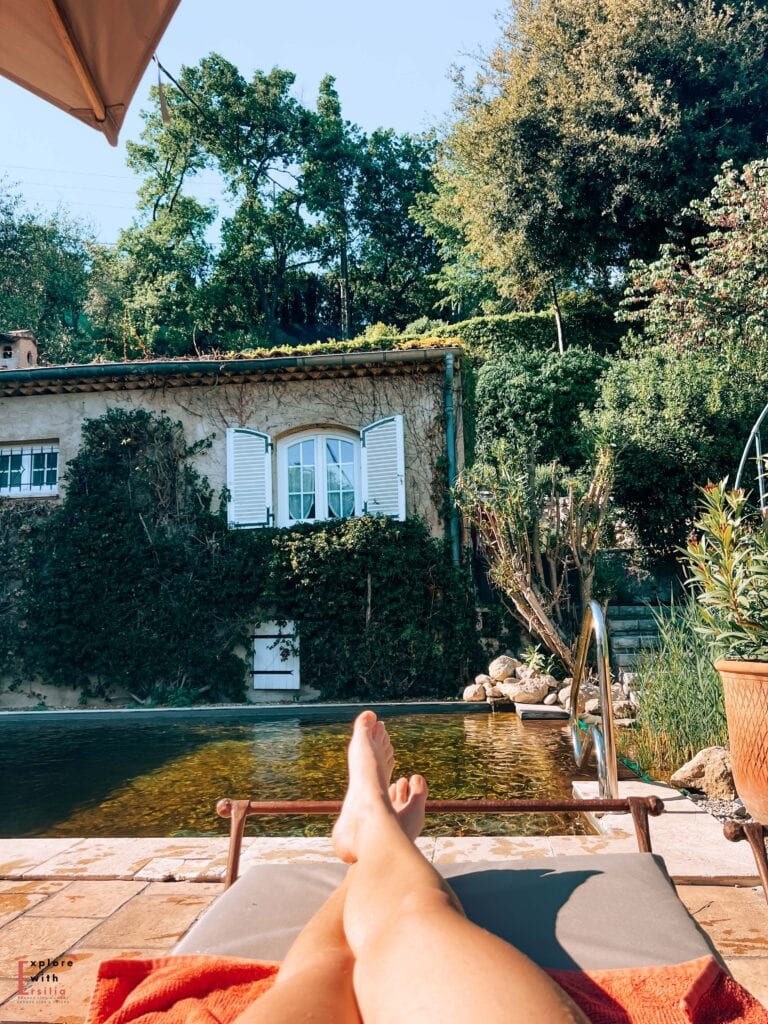
For a truly unique experience, book a room at Auberge De Tourrettes, which offers that perfect mix of authentic charm and modern comfort. This restored 18th-century mansion features rooms with original stone walls and contemporary amenities. The garden, filled with violet plants and Mediterranean herbs, is a peaceful retreat after a day of exploration. Each room tells its own story through carefully preserved architectural details and locally-crafted furnishings.
If you’re traveling with family or planning an extended stay, consider renting an apartment through Gîtes de France. Many local homeowners have restored historic properties while maintaining their authentic character. Some even offer private terraces with valley views – perfect for those long Provençal evenings.
Booking tips:
- Reserve at least 6 months ahead for violet season (January-March)
- Ask about parking availability – not all accommodations offer it
- Consider staying in nearby Vence for more options and lower prices
- Many places offer special rates for stays of a week or longer
Off the Beaten Path: Hidden Spots Nearby
While Tourrettes-sur-Loup captivates, the surrounding area holds its own treasures. The Gorges du Loup, just 15 minutes away, offers dramatic waterfalls and hiking trails far from tourist crowds. The Cascade de Courmes is particularly spectacular and easily accessible via a short trail.
You can take a kayak adventure on the river. We had to try it, as this is our favorite sport! Unlike going down the Dordogne river while enjoying impressive views of medieval castles, this experience was completely different! This river is a lot less calm and it definetly is an activity for the ones who have some experience in kayaking.

For a unique adventure, follow the lesser-known Route des Violettes, a driving circuit connecting various violet farms in the area. Many are family-run operations happy to share their cultivation secrets. Call ahead to arrange visits, especially during harvest season.
Don’t miss the tiny chapel of St-Arnoux, perched on a hill just outside town. This 12th-century gem is often overlooked by visitors but offers both historical charm and panoramic views of the coast. Local tip: pack a picnic and time your visit for sunset.
Why Visit Tourrettes-sur-Loup?
In a region famous for its medieval villages, Tourrettes-sur-Loup stands apart. It’s not just its dramatic setting or its violet heritage, but the way it has maintained its authentic soul while embracing its artistic identity. Here, you’ll find the Provence of your dreams – where ancient stones tell stories, artists work in centuries-old workshops, and the scent of violets drifts through narrow streets.
This village reminds us that the most memorable places aren’t always the most famous. While crowds flock to Saint-Paul-de-Vence or Èze, Tourrettes-sur-Loup offers something increasingly rare: a chance to experience a medieval French village that still lives and breathes its traditions, without feeling like a museum piece.
Whether you come for the violet fields, the artisanal crafts, or simply to lose yourself in its medieval streets, Tourrettes-sur-Loup offers a slice of authentic Provence that stays with you long after you’ve returned home. Just remember to approach this special place with respect for its rhythms and traditions – after all, that’s what keeps its magic alive.
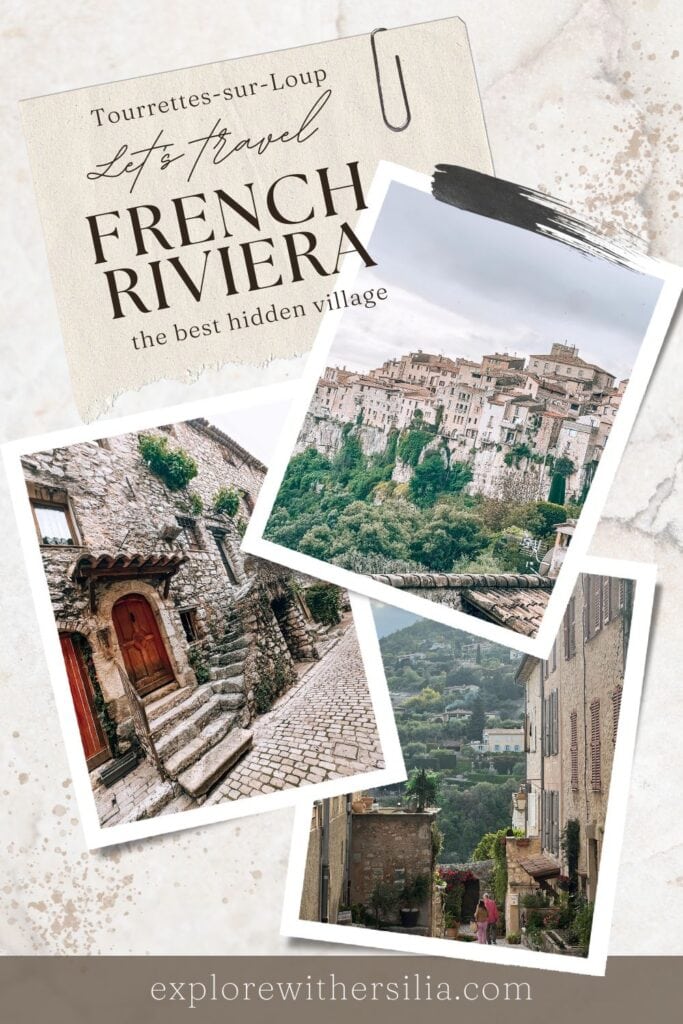
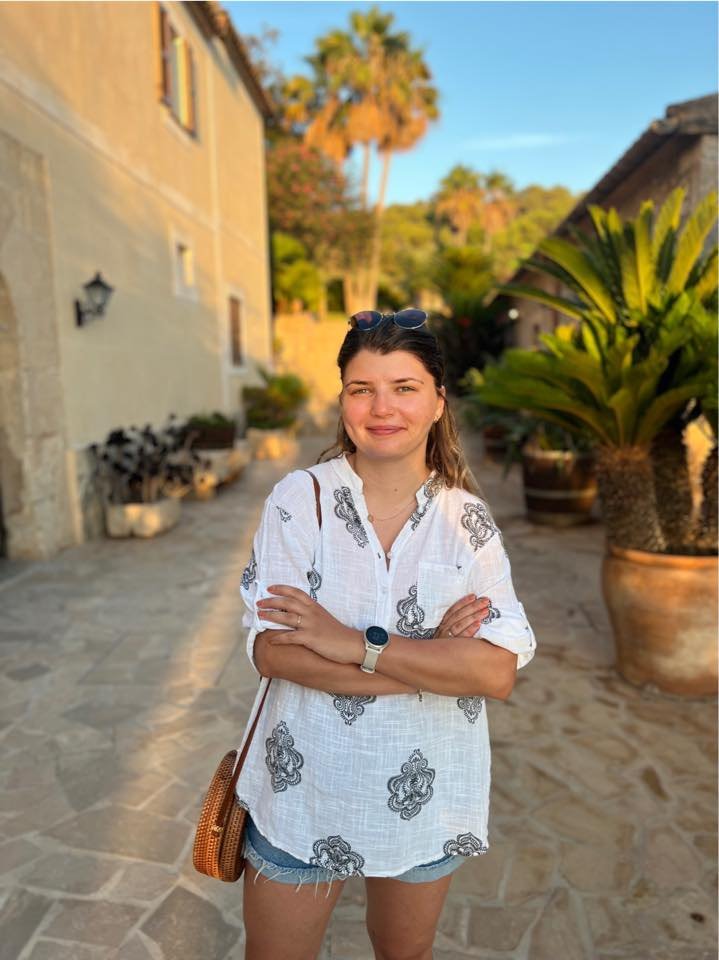
author page / EDITORIAL POLICY PAGE
Hi, I’m Ersilia

Toulouse, France

Originally from Romania

English & French Content
As a Romanian expat living in the heart of southern France, I guide English speakers to discover authentic French experiences without the language barrier. My unique perspective as both a local and an expat allows me to share insider tips, cultural insights, and practical advice that you won’t find in typical guidebooks.
My Expertise:
- French life and culture navigation
- Hidden gems across French regions
- Eastern vs Western European perspectives
- Local insights and practical travel tips
Blog Socials
Personal Pages


